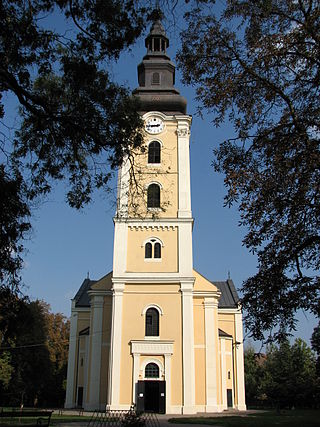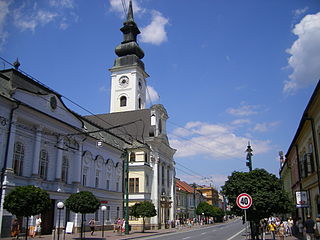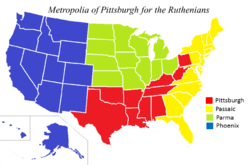
The Ruthenian Greek Catholic Church, also known in the United States as the Byzantine Catholic Church, is a sui iuris (autonomous) Eastern Catholic church based in Eastern Europe and North America. As a particular church of the Catholic Church, it is in full communion with the Holy See. It uses the Byzantine Rite for its liturgies, laws, and cultural identity.

The Greek Catholic Church in Croatia and Serbia or Byzantine Catholic Church of Croatia and Serbia, is a particular Eastern Catholic church in full communion with the Catholic Church. It consists of the Greek Catholic Eparchy of Križevci, covering Croatia, Slovenia, Bosnia and Herzegovina, and the Greek Catholic Eparchy of Ruski Krstur, covering Serbia. The Eparchy of Križevci is headed by Bishop Milan Stipić since 2020. The Eparchy of Ruski Krstur is headed by Bishop Đura Džudžar since 2003.

The Holy Protection of Mary Byzantine Catholic Eparchy of Phoenix, commonly known as the Eparchy of Phoenix and formerly known as the Byzantine Catholic Eparchy of Van Nuys, is a Ruthenian Greek Catholic Church territory jurisdiction or eparchy of the Catholic Church in the western United States. Its episcopal see is Phoenix, Arizona. The last bishop was the Most Reverend John Stephen Pazak.

The Hungarian Greek Catholic Church or the Byzantine Catholic Church in Hungary is a sui iuris (autonomous) Eastern Catholic church based in Hungary. As a particular church of the Catholic Church, it is in full communion with the Holy See. Its liturgical usage is that of the Byzantine Rite in the Hungarian language.

The Slovak Greek Catholic Church or Byzantine Catholic Church in Slovakia, is a sui iuris (autonomous) Eastern Catholic church based in Slovakia. As a particular church of the Catholic Church, it is in full communion with the Holy See. The church is organised as a single ecclesiastical province with one metropolitan see. Its liturgical rite is the Byzantine Rite. In 2008 in Slovakia alone, the Greek Catholic Church in Slovakia had some 350,000 faithful, 374 priests and 254 parishes. In 2017, the Catholic Church counted 207,320 Greek Catholics in Slovakia worldwide, representing roughly one percent of all Eastern Catholics.
Rusyn Americans are citizens of the United States of America, with ancestors who were Rusyns, from Carpathian Ruthenia, or neighboring areas of Central Europe. However, some Rusyn Americans, also or instead identify as Ukrainian Americans, Russian Americans, or even Slovak Americans.
Basil Takach was the first bishop of the Byzantine Catholic Metropolitan Church of Pittsburgh, the American branch of the Ruthenian Greek Catholic Church.
Nicholas Thomas Elko was an American Ruthenian Greek Catholic and the third bishop of the Byzantine Catholic Metropolitan Church of Pittsburgh. At the age of 46 he became the first American-born bishop of the Ruthenian Greek Catholic Church. He later served as Auxiliary Bishop of the Archdiocese of Cincinnati, a Latin Church archdiocese.
Stephen John Kocisko was the first Metropolitan Archbishop of the Byzantine Catholic Metropolitan Church of Pittsburgh, the American branch of the Ruthenian Greek Catholic Church
Thomas Victor Dolinay was the second Metropolitan Archbishop of the Byzantine Catholic Metropolitan Church of Pittsburgh, the American branch of the Ruthenian Catholic Church.

The Archeparchy of Pittsburgh is an archeparchy of the Ruthenian Greek Catholic Church that is located in the southern part of the United States of America. It is part of the Metropolis of Pittsburgh. The geographical remit of the archeparchy includes the states of Alabama, Arkansas, Kentucky, Louisiana, Mississippi, Pennsylvania, Tennessee, Texas, and West Virginia. The incumbent archeparch is the Most Reverend William C. Skurla. The episcopal seat is situated in the city of Pittsburgh.

The Eparchy of Passaic is an eparchy (diocese) of the Ruthenian Greek Catholic Church on the Atlantic seaboard of the United States. Its episcopal seat is the Cathedral of St. Michael the Archangel in Passaic, New Jersey. As an Eastern Catholic church, it uses the Byzantine Rite in its services. The Eparchy was erected July 6, 1963.

The Eparchy of Parma is an eparchy (diocese) of the Ruthenian Greek Catholic Church in the midwestern part of the United States. Its episcopal seat is the Cathedral of St. John the Baptist in Parma, Ohio. The eparchy's liturgies utilize the Byzantine Rite.

The Archeparchy of Prešov is an archeparchy of the Slovak Greek Catholic Church which is an Eastern Catholic particular church of the Catholic Church that is in full communion with the Holy See. The archeparchy is the metropolitan see of the Slovak Greek Catholic ecclesiastical province which covers the whole of Slovakia. The archeparch is also, ex officio, the metropolitan bishop of the metropolis. The geographical remit of the archeparchy itself is confined to the Prešov Region of Slovakia. The see is currently sede vacante. The cathedral church of the archeparcy is the cathedral of St. John the Baptist which is situated in Prešov. As an Eastern Catholic church, it uses the Byzantine Rite in the Slovak and Church Slavonic languages.

The Eparchy of Križevci is a Greek Catholic Church of Croatia and Serbia eparchy of the Catholic Church in Croatia, Slovenia, and Bosnia and Herzegovina. Its current eparch is Milan Stipić. The cathedra is in the Cathedral of the Holy Trinity, in the episcopal see of Križevci, Croatia.

The Apostolic Exarchate of the Greek Catholic Church in the Czech Republic is an exarchate of the Ruthenian Greek Catholic Church that was erected by Pope John Paul II on 13 March 1996. Its geographic remit includes the Czech Republic. As an Eastern Catholic Church, it is in full communion with the Catholic Church. The exarchate is exempt, which means that it does have a metropolitan bishop but is directly subject to the Holy See. It is supervised by the Roman Dicastery for the Eastern Churches, a Roman Curia dicastery acting on behalf of the Pope. Its parishes observe the Byzantine Rite, which is also celebrated by the majority of Orthodox Christians. The episcopal seat is the Cathedral of St. Clement in the city of Prague.

Saint Anne Byzantine Catholic Church is a Catholic Christian parish of the Byzantine Ruthenian Tradition located in the City of San Luis Obispo, California. It was founded in 1986. It is a parish of the Holy Protection of Mary Byzantine Catholic Eparchy of Phoenix.
William Charles Skurla is the Archeparch of the Archeparchy of Pittsburgh in the Ruthenian Greek Catholic Church. He is also, ex officio, the metropolitan bishop of the Metropolis of Pittsburgh whose geographic remit includes the entire United States and Canada. He succeeded Archbishop Basil Myron Schott. Skurla was appointed as metropolitan on 19 January 2012, by Pope Benedict XVI and enthroned at the Cathedral of St. John the Baptist in Munhall, Pennsylvania, on April 18, 2012.

The Exarchate of Saints Cyril and Methodius of Toronto is a ecclesiastical territory or exarchate that serves the Slovak Greek Catholic Church — a sui juris or self governing Eastern Catholic Church. Its geographical remit includes the whole territory of Canada. In 2022, Pope Francis transferred the ecclesiastical jurisdiction of the exarchate from the Slovak Greek Catholic Church to the Ruthenian Greek Catholic Church. It became part of the ecclesiastical Metropolis of Pittsburgh. This changed the territory's status from an eparchy to an exarchate at the same time.

The Ruthenian Uniate Church was a particular church of the Catholic Church in the territory of the Polish–Lithuanian Commonwealth. It was created in 1595/1596 by those clergy of the Eastern Orthodox Church who subscribed to the Union of Brest. In the process, they switched their allegiances and jurisdiction from the Ecumenical Patriarchate of Constantinople to the Holy See.












